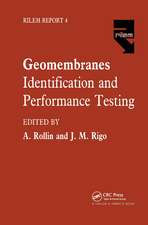The Pneumatic Flow Mixing Method
Editat de Masaki Kitazumeen Limba Engleză Paperback – 30 iun 2020
The Pneumatic Flow Mixing Method is a useful reference tool for engineers and researchers involved in admixture stabilization technology everywhere, regardless of local soil conditions and a variety in applications.
Preț: 434.84 lei
Nou
Puncte Express: 652
Preț estimativ în valută:
83.20€ • 86.88$ • 68.71£
83.20€ • 86.88$ • 68.71£
Carte tipărită la comandă
Livrare economică 15-29 aprilie
Preluare comenzi: 021 569.72.76
Specificații
ISBN-13: 9780367574246
ISBN-10: 0367574241
Pagini: 250
Dimensiuni: 174 x 246 x 13 mm
Greutate: 0.42 kg
Ediția:1
Editura: CRC Press
Colecția CRC Press
ISBN-10: 0367574241
Pagini: 250
Dimensiuni: 174 x 246 x 13 mm
Greutate: 0.42 kg
Ediția:1
Editura: CRC Press
Colecția CRC Press
Public țintă
Professional Practice & DevelopmentCuprins
1. An overview of Admixture Stabilization – Evolution of Pneumatic Flow Mixing and Scope of the Book
1 Introduction
2 Cement admixture stabilization techniques
3 Development, mechanism and applications of the Pneumatic Flow Mixing method
4 Scope of the textbook
2. Factors Affecting Strength Increase
1 Introduction
2 Mechanism of cement stabilization
3 Influence of various factors on stabilization effect
4 Prediction of strength
3. Engineering Properties of Stabilized Soils
1 Introduction
2 Properties of stabilized soil mixture before hardening
3 Properties of stabilized soil after hardening
4 Properties of stabilized soil subjected to disturbance/compaction
5 Engineering properties of cement stabilized soil produced in-situ
6 Summary
4. Applications
1 Introduction
2 Improvement purposes and applications
3 Selected case histories of the method in Japan
5. Equipment, Construction, and Quality Control and Assurance
1 Introduction
2 Equipment
3 Construction procedure
4 Quality control
6. Geotechnical Design of Stabilized Soil Ground
1 Introduction
2 Design strength
3 Geotechnical design
APPENDIX A Japanese Laboratory Mix Test Procedure
1 Introduction
2 Testing equipment
3 Making and curing of specimens
4 Report
5 Use of Specimens
1 Introduction
2 Cement admixture stabilization techniques
3 Development, mechanism and applications of the Pneumatic Flow Mixing method
4 Scope of the textbook
2. Factors Affecting Strength Increase
1 Introduction
2 Mechanism of cement stabilization
3 Influence of various factors on stabilization effect
4 Prediction of strength
3. Engineering Properties of Stabilized Soils
1 Introduction
2 Properties of stabilized soil mixture before hardening
3 Properties of stabilized soil after hardening
4 Properties of stabilized soil subjected to disturbance/compaction
5 Engineering properties of cement stabilized soil produced in-situ
6 Summary
4. Applications
1 Introduction
2 Improvement purposes and applications
3 Selected case histories of the method in Japan
5. Equipment, Construction, and Quality Control and Assurance
1 Introduction
2 Equipment
3 Construction procedure
4 Quality control
6. Geotechnical Design of Stabilized Soil Ground
1 Introduction
2 Design strength
3 Geotechnical design
APPENDIX A Japanese Laboratory Mix Test Procedure
1 Introduction
2 Testing equipment
3 Making and curing of specimens
4 Report
5 Use of Specimens
Notă biografică
Masaki Kitazume is professor of Geotechnical Engineering at the Department of Civil and Environmental Engineering at Tokyo Institute of Technology, Japan. He has over 35 years of experience in research and teaching of soil stabilization, ground improvement and foundation engineering, and published several text books on the design and quality control and assurance of ground improvement techniques including the deep mixing method and the sand compaction pile method.
Descriere
The book presents the state of the art in the pneumatic flow mixing method, and covers recent technologies, research activities and know-how in machinery, design, construction technology and quality control and assurance.


















